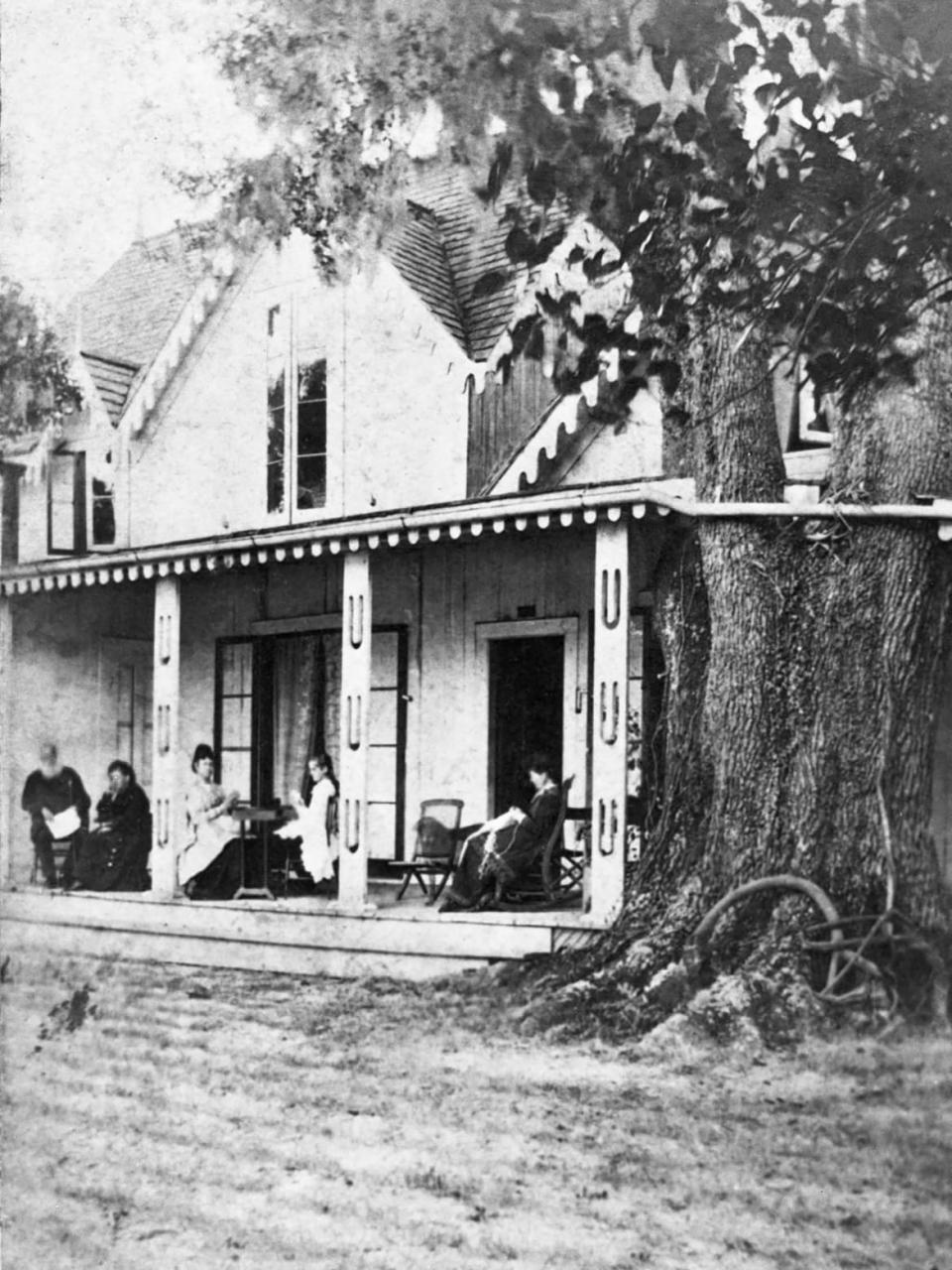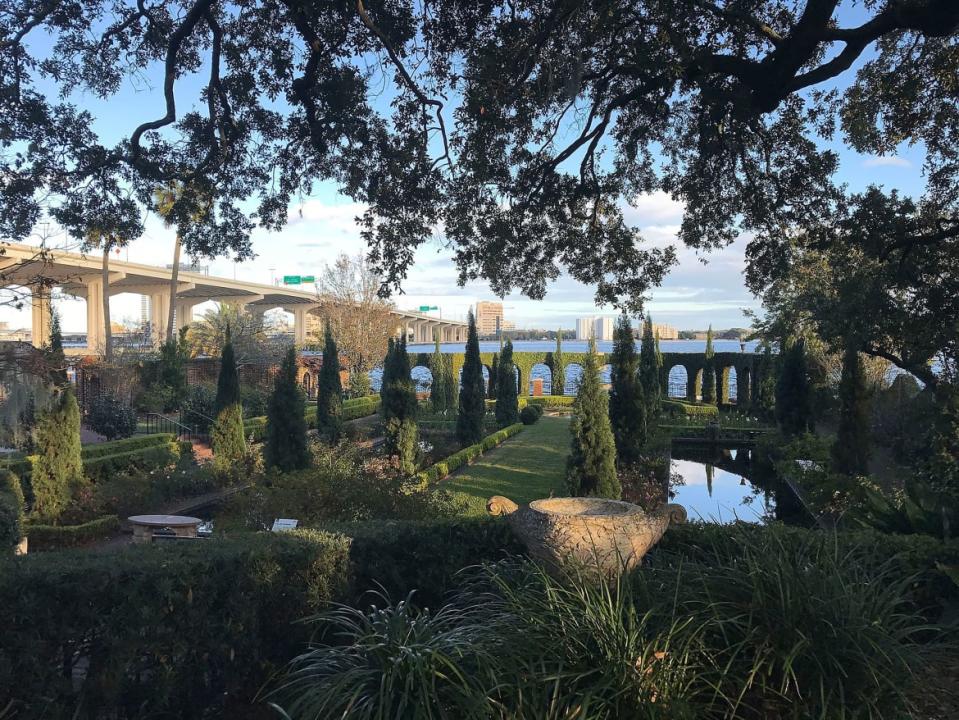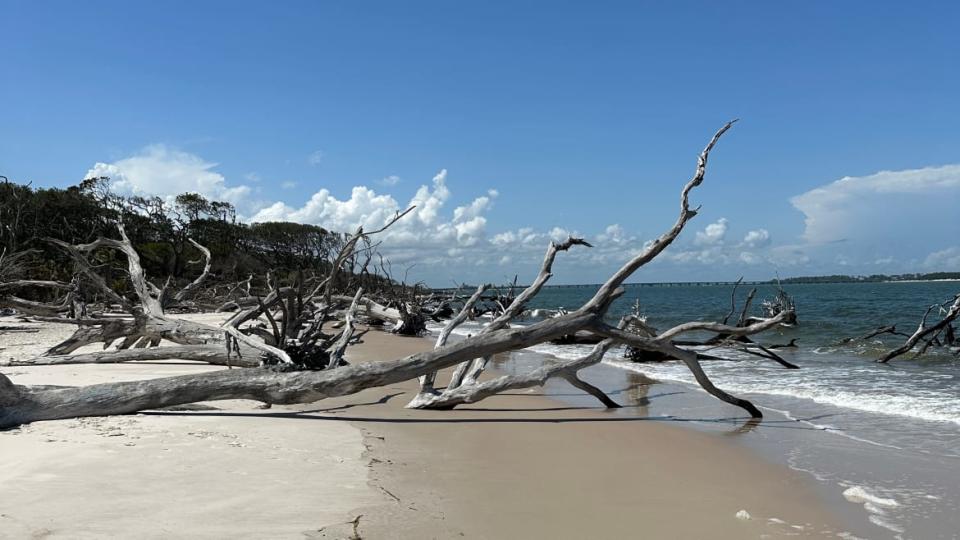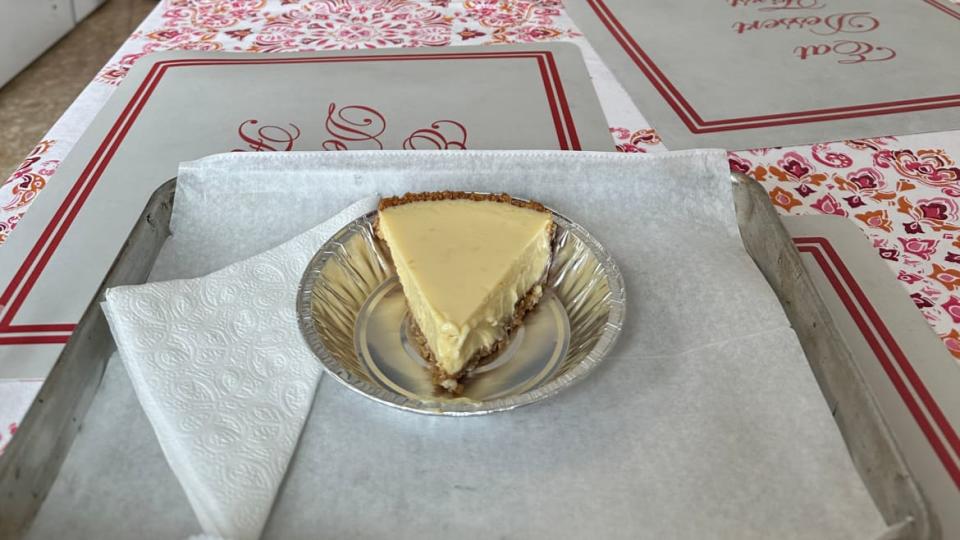Is America’s Largest City Also Its Most Misunderstood?

She may have made Queen Victoria weep, written the best-selling book of the 19th century, and been told by Lincoln she was the woman “that started this great war,” but my favorite thing about Harriet Beecher Stowe is that she was essentially the original weird Florida attraction.
In the years after the Civil War, Stowe moved to Mandarin across the river from Jacksonville. Long before Palm Beach and Miami were twinkles in Henry Flagler’s hungry eyes, tourists flocked to the Jacksonville area. It was a city of luxury hotels, exciting attractions, upper-class foreigners, and it was also the entrance to one of America’s most exciting “frontiers”—the St. Johns River. Dubbed the “Nile of America” since it, too, flowed south to north, the St. Johns River was the first main driver of tourism in Florida. Beginning in the 1840s, steamships arrived daily carrying passengers from New England and New York, stopping at Savannah or Charleston along the way.
Tourists usually spent some time in the city and then headed up the river. The St. Johns might as well have been the Amazon to these travelers, and for a sight of the relatively untamed is why they came. The river promised lots of wildlife, lush flora, eccentricities like the “cracker” houses along the banks, scenic villages and resorts, and a possible cure for respiratory ills. Grant and Lee made the trip (not together), so too did Winslow Homer. The high-end possibilities of its towns were so mouthwatering that William Astor tried to take a bite.

Harriet Beecher Stowe and her family sit on the porch of her Mandarin house.
Stowe and family came here both for the climate and to make a little money. The latter didn't entirely work out but the former kept her here for decades on a 30-acre citrus farm on Mandarin Point across the river from Jacksonville. Catching a peek at Stowe, or buying one of her oranges, was a must for visitors. As the journalist Bill Belleville writes in his engrossing River of Lakes: A Journey on Florida’s St. John’s River, “the steamer Mary Draper would charge tourists seventy-five cents for a round trip from Jacksonville to Mandarin, promising a glimpse of the writer at work on her porch.” Stowe left town in the 1880s. So, too, did the tourists. The railroad choked tourism to this area, and the major destinations on Florida’s east coast became Palm Beach, Miami (whose population then was a half dozen people), and St. Augustine. Her house no longer exists, and on the waterfront where it would have been is a lovely park with boardwalk trails looking out through cypress trees onto the river.
On a misty Thursday afternoon a couple of weeks ago, I parked my rental car on a nearby street lined with live oaks and Acadian houses putting on airs. It was my final stop before heading to the airport, a last stab at finding the traces of old Jacksonville in my few days visiting for our series on underrated destinations, It’s Still a Big World. What I found in my time there is that Jacksonville is undoubtedly underrated, and misunderstood.
Florida's most populous city
So much about a place can be surmised from above, and that’s certainly the case when descending into Jacksonville. You’re struck first by the wild beauty of the islands and swirling rivers that make up the coast of the Florida-Georgia borderlands. The eagle-eyed can usually spot the ruins of Dungeness, the old Carnegie family estate. You can also spot some plants (of the industrial variety), and then, sprawl. Jacksonville is actually the largest city in the contiguous U.S. in terms of land. Yes, the town of Tribune, Kansas is bigger but it has a mere 1,182 people. Jacksonville is also Florida’s most populous city.
That population is spread out in what is essentially uninterrupted development from the Jacksonville beaches on what some are trying to call San Pablo Island (it's currently unnamed) west to the St. Johns River and across its murky waters towards central Florida.
While many people visiting Jacksonville with time to kill would pop up to Cumberland Island and see the wild horses or to more upscale Amelia Island, or even down to historic St. Augustine, I was determined to stay within the (broad) confines of Jacksonville itself. My home for those few days was just off the historic center and on the riverfront—the Hyatt Regency Jacksonville Riverfront—which was playing host to a sporting goods conference.
One afternoon, I took a river boat tour with the St. Johns River Taxi. My guide was a guy named Monty. Leathery, sinewy, and prepped with an infinite supply of aphorisms, he’s the type that’s cruised this river for two centuries.
“The farther north you go in Florida,” he quips at one point, “the farther south you are.” The saying has political connotations, but it captures the first shock to the prejudicial eyes once you start walking and driving around this place. With the live oaks and voluptuous magnolias, the old rambling Victorians, Arts & Crafts bungalows, and shotgun houses, you would swear you were the heart of the Deep South. The saying also rings true when it comes to food. Sure, Miami and Palm Beach have snazzy restaurants with elevated concepts and food that’s good for you. But like much of the Deep South, in Jacksonville I ate food that was, simply, good.
A great place to get your bearings is at Biscottis, a bistro that can throw down with any lunch place in the world as far as I’m concerned. Plus, it has waitresses that say things in a drawl like, “You ladies want training wheels with that?” to guests who order vodka straight up—meaning do they want lemons or lime. The restaurant is on St. Johns Avenue, a classic Main Street USA-type strip that runs through the neighborhood of Avondale and then morphs into Riverside Ave. as it goes through neighboring Five Points. Next door to Biscottis is Southern Grounds & Co, which could out-millennial any coffee shop anywhere with its industrial-chic decor and modern bites. Walking up and down the few blocks here, it also becomes apparent that you can and will want to get dessert everywhere. Just a couple streets away is the award-winning Restaurant Orsay. It’s fine dining, but it’s also Jacksonville, which means it is very laid back. And it being the South, the drinks here were no joke.
After you’ve had your fill, you’re going to want to either head south along the river, or north to downtown since in either direction one can find an outpost of one of Jacksonville, nay, Florida’s, greatest treasures–Chamblin’s. It’s hard to explain it until you’ve seen it in person, but imagine corridor after corridor of used books ranging from obscure erotic works to specific history genres to fancy coffee table books for just a handful of dollars. Just wandering up and down its aisles is dangerous for those of us who already have stacks of books we should read but never will. But it’s also an awkward reminder of how the lifelong work of so many never quite lasts in the popular consciousness. I snagged books on Palladio, Victorian Florida, Greek Revival architecture, and Mapplethorpe.
I asked one of the front desk workers why bookstores of such breadth are here in Jacksonville. Her response? “Jacksonville is pretty sleepy so people have a lot of time to read, and there are a lot of strange people.” There is a sleepiness to the area, which if you want a city that’s buzzing and exciting might disappoint you, but for those looking for somewhere relaxed, there’s tremendous appeal. And while there isn’t a dazzling array of cultural institutions, it has a star in its main attraction—the Cummer Museum of Art & Gardens.
At one point, the aforementioned Riverside Ave. was lined with elegant mansions that backed onto the river. A couple of those were owned by the Cummer family, lumber magnates from Michigan who at one point were the largest landowners in Florida. Florida was once a titan in the lumber and cattle industries, and Jacksonville was the commercial center of those trades.

The Italian Garden of the Cummer Museum.
In the 1960s, the family estates and collection were turned into the museum (sadly the original homes were torn down to build the Art Deco building housing it today). More than anything the museum does American art serious justice, showcasing works by Benton, Eakins, Sargent, Bellows, Curry, Duncanson, Homer, Moran, West, and Hassam. Normally, I glide right past any cases with porcelain, but the Cummer has one of the world’s most significant holdings of Meissen porcelain. It’s a reminder of the random stuff rich people in America collect—in this case the Warks—and the power the dollar can wield. What was delightful about it was the museum actually captures your interest and appreciation with good stories about the struggle involved in making Meissen porcelain. While the original mansions are gone, the elaborate gardens out back are still there to give an idea of what might have once lined the river.
The museum has a number of exhibitions throughout the year, and right now is a small one on movie posters for films produced by Norman Studios. Apparently, before the film industry settled down in Hollywood, Jacksonville was one of its epicenters. Metro Pictures, the Metro in Metro-Goldwyn-Mayer (MGM) started here. The access to the river, the ocean, jungle, historic towns like St. Augustine, and the city’s status as a rail center made it ideal. But the moviemakers were essentially run out of this conservative town. It wouldn’t be the last time the area said “thanks but no thanks” to Hollywood’s money. Disney reportedly wanted to put Disney World here, but the mayor told Walt, "I don't deal with carnival folk.” A man named Richard Norman jumped on the firesale, bought one of the filming complexes, and began creating a string of movies starring Black actors and made for Black audiences. Norman Studios would produce at least eight films, although only one—The Flying Ace—survives. The Great Depression would wipe out the studio, but it was just one tiny piece of Jacksonville’s incredibly rich role in Black, and therefor American, cultural history.
This Tiny Country Is a Less Crowded, Less Expensive Costa Rica
The neighborhood of LaVilla doesn’t look like much these days. It’s identical to any number of city neighborhoods nationwide ravaged by freeways and neglect—as well as the 1901 Jacksonville fire, the third worst city conflagration in U.S. history. Except LaVilla was once the center of Black life in Jacksonville, and thus, depending who you ask, at the center of Black life in America at the turn of the century. Ray Charles, Ma Rainey, and Zora Neale Hurston all spent formative years here. James Weldon Johnson and his brother wrote “Lift Every Voice and Sing” (commonly referred to as the Black National Anthem) while Johnson was a principal In town. LaVilla was referred to as “the Harlem of the South.” While Jacksonville has ample room to grow to lean into its rich Black history, a good place to get your bearings is at the Ritz Theater & Museum. Built on the site of the old Ritz Theater where Ray Charles got his start, it has a little museum inside which includes an animatronic show on Johnson’s life and displays about the community’s history.
Music history runs deep here generally. Lynyrd Skynyrd was formed in Jacksonville. So, too, was the Allman Brothers Band. The Florida Theater, where Elvis debuted his infamous lip curl, still puts on shows.
Sublime Nature
My second day in Jacksonville, though, wasn’t focused on what once was, but rather something incredible the city has within its limits—sublime nature.
Whether because of politics or class, there’s a temptation not to fully appreciate the spectacular beauty of Florida. If you were in any other country and driving the A1A onto Talbot Island you’d declare it one of the most picturesque things you’d ever seen. The beaches are a pristine white on the ocean side of the bridge and on the other precarious islands of marsh grass and cypress dot the land like spots on a cow. I’d picked up food at Community Loaves, a bakery so good I went back multiple times. There’s something to be said for a town that has a bakery as good as any major city and you can just roll up with no line. Loaded with carbs, I picked up my bike at Kayak Amelia and cruised along Big Talbot Island, one of a number of these barrier islands that make up the “North Florida Keys.” While it was simply nice to get out and into this unique landscape, wandering amongst the blasted tree trunk ruins on Boneyard Beach is a must.

The blasted remains of trees that festoon the beaches on Talbot Island.
Drenched in sweat and with more than a few bug bites, I stopped on my way back to town at Huguenot Memorial Park, a Cape Cod-looking fish hook-shaped peninsula on the northern side of the mouth of the St. Johns. I parked in a lot by a cove with clear water and squishy sand likely rich in shellfish. As I squelched my way along its shore, SUVs and trucks rolled by, since the main beach here is one you can drive right onto (my rental car, alas, would not have been up to the task). I stripped down, put my stuff into a pile hoping it wouldn’t get run over, and jumped into the waves. Bobbing about, I looked back at the lovely beach lined for hundreds of yards with giant cars. Anywhere else it might have been jarring, but here in northern Florida it looked just right.

A perfect slice of pie served In the simplest of surroundings at Pie Heaven.
Like most former industrial cities, Jacksonville is going through a hard-fought revitalization of its urban core. But one neighborhood you shouldn’t miss while you’re in town is just north of downtown: Springfield. It’s home to some of the city’s most charming blocks of historic house as well as restaurants and coffee shops where you’re guaranteed to run into the young and adventurous taking part in that revitalization. While in the neighborhood, fill up at 1748 Bakehouse with comforting soups and sandwiches. They had, no lie, the best pumpernickel bread I’ve ever tasted. Speaking of best things I’ve ever tasted. The bakery rated number one pie shop in Florida, Mixed Fillings, was closed the week I was there. Luckily, Jacksonville also has the bakery that came in third in the state, Pie Heaven, where I got my fix of key lime pie and restrained myself from taking one home.
Harriet Beecher Stowe is long gone, but there’s still plenty to see should you decide to stop here. Perhaps you’ve already done St. Augustine and you want something a little more colorful, a place still on its way to becoming something. Or perhaps you’re in town for business and need a good place to eat where you can walk in neighborhoods lined with live oak. Or maybe, just maybe, you’ve discovered you actually are keen to finally learn why rich people care so much about porcelain from Germany.
Get the Daily Beast's biggest scoops and scandals delivered right to your inbox. Sign up now.
Stay informed and gain unlimited access to the Daily Beast's unmatched reporting. Subscribe now.

 Yahoo Finance
Yahoo Finance 